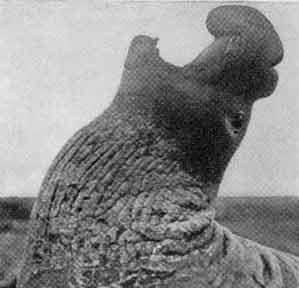Elephants of the Sea
By LEWIS W. WALKER
Nature Magazine, March 1932
Page 1 | Page 2
Until a few weeks ago, the famous elephant seals of Guadalupe Island seemed entirely out of reach, as far as I was concerned. Five times I had started for the Island, but on each occasion something came up to change the destination of the boat. So when I recently boarded the Velcro III with a party of San Diego scientists, and the Diesel-powered craft headed toward Guadalupe, I was hopeful, yet skeptical. And I remained in doubt until, at last, we rounded a rocky point, and came in sight of a secluded narrow beach, backed by precipitous walls of lava, two thousand feet high. Guadalupe at last! As we came in we could see with the naked eye gray forms just above the water markforms that looked more like rocks than mammals. Glasses, however, proved them to be elephant seals the largest of the true seals, and, with the exception of the Guadalupe fur seals, probably the rarest members of their family.

A ROARING BULL OF GUADALUPE
Making a landing had its thrilling moments, although we were fortunate in encountering a fairly calm surf. When we were fifty feet from the beach a massive object loomed up in the water before us. It was too late to stop when we spied it, for a wave was pushing us on. A lazy tail rose above the water on the port side of the dory, while a heavy head, adorned with a bulky proboscis, stirred the water on the starboard. Cameras were raised high in the air, for a spill was expected, but the half-submerged bull did not seem to mind having his back scratched as we slid over. In a few seconds the water became shallow enough to permit us to leap and run for dry land, land which was covered to a great extent by huge marine mammals. These monster seals, which occasionally reach twenty feet in length and weigh almost four tons, seemed to have no fear at all of humans. Raised heads and muffled grunts were their only protests as we passed freely in and out among them.
The elephant seal, which is slowly making a comeback from the very verge of extinction, has several very peculiar characteristics. The name "Elephant of the Sea" is gained from the trunk-like, elongated proboscis of the males. As far as is known, this organ has no use in connection with the animal's livelihood. The roaring bulls often allow it to drop inside their mouths, where it becomes inflated and appears to act as a resonator. As the nose on the cow elephant seal tends more toward the "normal", it is believed that the lengthened appendage has nothing to do with the catching of food.
All of the comparatively few scientists who have visited this elephant seal beach have been struck by the almost total absence of females and young; yet the herd is increasing. Fifteen years ago there were but eighty animals; this spring the herd was estimated to number fifteen hundred animals.
Page 1 | Page 2
 Printer-friendly version
Printer-friendly version
